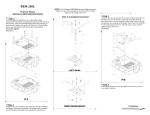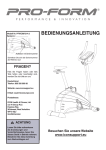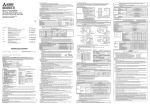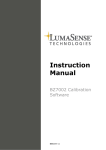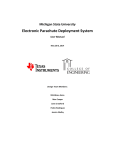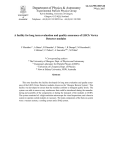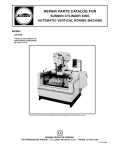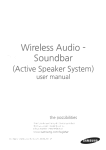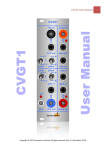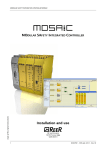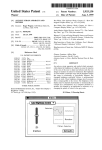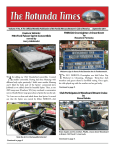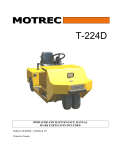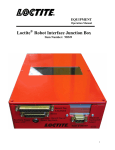Download g \ `\ 597/ \<\ i
Transcript
US006154817A Ulllted States Patent [19] [11] Patent Number: Mohan et al. [45] [54] Date of Patent: 5,673,382 9/1997 Cannon et al. .................. .. 395/18204 STORAGE MEDIA 5,734,894 3/1998 Adamson .............................. .. 707/200 OTHER PUBLICATIONS Christopher/51011”), Baby10n;_ Harry “Ozone Backup (2.02)—Reference & User Manual”, Chap Gosqell, Amlty Harbor; Maoplng C30, ter 3 (pp. 3—1 through 3—6), Chapter 9 (pp. 9—1 through Bayslde; Dwayne Rambal‘l‘all, South Ozone Park, 9119f N-Y- 9—37) and tWo cover pages, Edition 4.2, Copyright 1990_1993 OZone Systems Pty Ltd. _ _ “UCC One User Manual”, Section 1, pp. 1—1 through 1—9, [73] Ass1gnee: Cheyenne Software International Sales Corp" Dallas’ TeX‘ Notice: authods) unknown, May 1987_ “Chapter 3. Setting Options and Organizing Tape Pools”, pp. This patent issued on a continued pros- 3'1_3'21’ author(s) and date unknown ecution application Primary Examiner_l—liep under 15301), and is Subject to the twenty year patent term provisions of 35 U.S.C. [57] Appl- N05 08/767,161 [22] Filed: Nguyen Attorney, Agent, or Firm—Robert D. Schaffer; Clifford Chance Rogers & Wells LLP 154(a)(2). [21] *Nov. 28, 2000 DEVICE AND METHOD FOR MANAGING [75] Inventors: Deepak Mohan, Huntington; [*] 6,154,817 ABSTRACT A device and method for managing storage media is dis Dec_ 16, 1996 closed herein. The storage media is initially associated vvith a ?rst set or a second set in the device. The device comprises [51] [52] [58] Int. Cl.7 .................................................... .. G06F 12/16 US. Cl. .......................... .. 711/162; 711/165; 707/204 Field of Search ................................... .. 711/161, 162, a managing device for executing selectable storage rules. The selectable storage rules are for determining a ?rst storage media, initially in the ?rst set, to which data is to be 711/111, 112, 165; 707/204 stored. The managing device is also for executing selectable usage rules, Wherein the selectable usage rules are for [56] References Cited determining a second storage media, initially in the second set, to be transferred from the second set to the ?rst set. The device also has a storage device in communication With the managing device adapted for transferring data to the ?rst storage media in accordance With said selectable usage rules, US‘ PATENT DOCUMENTS 3,715,727 2/1973 Yu ......................................... .. 395/821 5,267,351 11/1993 Reber et a1, ,, 707/104 5,276,867 1/1994 Kenley ........ .. 5,287,459 2/1994 GnieWek 53177728 5/1994 Tev1s_ et a1 .. 707/204 so that When data is to be stored to the ?rst storage media, ---- -- 369/34 the managing device applies the selectable storage rules for 574697560 11/1995 Begun """"" " 5’469’573 11/1995 M06111’ HI 5,475,834 5,522,037 5,664,186 12/1995 Anglin et al. . 5/1996 Kitagawa .... .. 707/204 determining the ?rst storage media and applies the selectable 711/112 " 395/712 usage rules for determining the second storage media to be transferred from the second set to the ?rst set 707/203 395/18316 ' 9/1997 Bennett ................................. .. 707/204 30 Claims, 11 Drawing Sheets __.__\ I I I :\ / 30 l CLIENT \ MEDIA POOL J1 \: 1 2 HOSI COMPUTER | | a g u \ -—4 J4 MEDIA STORAGE DEVICE / // ‘f5 \\ \ 597/ 1:5 \<\ i ‘is MEDIA MEDIA O 0 MEDIA FOOL SCRATCH SEI \S MEDIA SAVE SET \ O coo 5|“ / MEDIA POOL ‘\ \S 5i 6a MEDIA / 50 MEDIA U.S. Patent Nov. 28,2000 Sheet 1 0f 11 6,154,817 _. __ _-l 1 | a | \ | 30 I J2 l CLIENT : HOST COMPUTER | I | | l _ _ _J J4 J5 STORAGE DEVICE / 51° ‘v / / \ // \\ \ 5a \/ \ / \ / MEDIA POOL 1 \ O O s 0 MEDIA POOL a FIG. I U.S. Patent Nov. 28,2000 Sheet 2 0f 11 6,154,817 /2 7o 70 00%55 DATABASE fzoo MEDIA POOL MANAGER nosr COMPUTER FIG. 2A U.S. Patent Nov. 28,2000 Sheet 3 0f 11 222 (MEDIA POOL RECORD) MEDIA-POOL—ID 222A MEDIA-POOL-NAME 222B MIN-SAVE-COPIES 2220 BASE-SERIAL-NUMBER 222D NEXT-SERIAL-NUMBER 222E SERIAL-NUMBER-RANGE 222F SAVE-SET-RETENTION-PERIOD 2220 FIG. 2B 224 (MEDIA RECORD) MEDIA-ID 224A MEDIA-NAME 224B SEQUENCE-NUMBER 2240 RANDOM-ID 224D MEDIA-SERIAL-NUMBER 224E LAST-WRITE-INFO 224F DESTROYED~DATE 224s MEDIA-POOL-ID 224H MEDIA-POOL-SET 2241 MEDIA-LOCA'I'ION-STATUS 2241 LOCAHON-ID 224K FIRST-FORMAT-DATE 224L LAST-FORMAT-DATE 224M LAST-READ-DATE 224N REHRE-DATE 2240 MEDIA-STATUS 224P NUMBER-OF-PASSES 2240 FIG. 2C 6,154,817 U.S. Patent Nov. 28,2000 Sheet 4 0f 11 6,154,817 226 (LOCATION RECORD) LOCATION-ID 226A LOCATION~INFO 226B SENDER-INFO 226C FIG. 2D 228 (JOB RECORD) — JOB-ID 228A JOB—OWNER—NAME 228B JOB-START-DATE 228C JOB-TYPE 2280 FIG. 2E 230 (SESSION RECORD) SESSION-ID 230A Joe-Io 230B MEDIA-ID 2300 SESSION-TYPE 2300 SESSION-NUMBER 250E HOST-ID 23OF PATH-ID 2306 FIG. 2F 232 (FILE RECORD) SESSION -—ID HOST—ID PATH-ID FIG. 26 U.S. Patent Nov. 28,2000 Sheet 5 0f 11 MEDIA POOL ‘K2 Si 60 MEDIA 000 MEDIA SAVE SET ‘13 60 60 60 60 MEDIA / MEDIA / MEDIA SCRATCH SET FIG. 3 MEDIA 6,154,817 U.S. Patent Nov. 28,2000 Sheet 6 0f 11 PROCESS 400 6,154,817 405 410 PROMPT USER / FOR INFORMATION I STORE DATA IN RECORD 222 420 PROMPT USER FOR INFORMATION AND STORE DATA IN RECORD 226 YES 430 CREATE ANOTHER OFFSITE LOCATION PREASSIGN NO MEDIA INSERT MEDIA AND FORMAT GET AND STORE DATA 440 U.S. Patent Nov. 28,2000 Sheet 7 0f 11 6,154,817 PROCESS 500 502 505 RESTORE GET BACKUP OPTIONS, IF ANY / 51o 540 SELECT FILES TO / RESTORE 520 ENTER STORAGE / RULES SPECIFY TIME 545 PROVIDE INFORMATION / TO USER / 525 TO RUN SUBMIT JOB T0 / 55o ‘JOB QuEuE” 555 END FIG. 5 U.S. Patent Nov. 28,2000 PROCESS e00 Sheet 8 0f 11 6,154,817 605 START 610 PICKUP JOB FROM QUEUE / 613 JOB: BACKUP N Y 615 ACCESS BACKUP / OPTIONS + /620 PERFORUOEROCESS INSERT MEDIA + RUN BACKUP 530 / + 660 / JOB /535 UPDATE DATA MOVE MEDIA + RUN RESTORE JOB + /655 + UPDATE INFORMATION /640 USED + 645 PERFORM PROCESS / 800 650 FIG. 6 /665 U.S. Patent Nov. 28,2000 Sheet 9 0f 11 6,154,817 PROCESS 700 705 _ FROM 754 740 \ 710 PROMPT TO INSERT MEDIA WITH SPECIFIED MEDIA NAME IF NOT “t. OR A LIST OF MEDIA FROM THE SCRATCH SET IF IT IS AN OVERWRITE JOB, OR A BLANK MEDIA CLEAR MEDIA CANDIDATE LIST (INCLUDE ONE BLANK MEDIA) 712 73 ARE THERE ANY MoRE MEDIA IN THE DATABASE? N0 ARE THERE ANY MEDIA IN THE MEDIA CANDIDATE LIST? NO FROM 744 YES 714 DOES THE MEDIA POOL YES 718 IS THE MEDIA IN THE SCRATCH SET? NO , 724 IS IT AN OVERWRITE SAME NAME ONLY DOES THE MEDIA NAME MATCH? ADD MEDIA TO CANDIDATE LIST I \ TO 742 ' U.S. Patent Nov. 28,2000 Sheet 10 0f 11 6,154,817 PROCESS 700 742 FROM 734 SORT MEDIA CANDIDATE LIST TO 71o\ 75s REMOVE MEDIA 7 4 FROM THE LIST 7 IS THE NEXT MEDIA IN THE LIST 758\_ 746 FORMAT THE MEDIA FIG. 7B PROMT FOR THE HIGHSET SEQUENCE U.S. Patent Nov. 28,2000 Sheet 11 0f 11 6,154,817 PROCESS 800 :80 1 GET NUMBER OF “805 GOOD MEDIA ACCESS FIRST GOOD MEDIA 840 ACCESS NEXT GOOD MEDIA A GET HIGHEST SEQUENCE J83‘) NUMBER FOR MEDIA UPDATE MEDIA POOL SET I DOCUMENT MEDIA IN SAVE SET RETENTION PERIOD ELAPSED 6,154,817 1 2 DEVICE AND METHOD FOR MANAGING STORAGE MEDIA manually labeled and managed according to a user’s indi vidual handling system. Such manual operations reduce the ef?ciency selecting backup media and increase a likelihood that a media containing currently needed backup data Will be BACKGROUND OF THE INVENTION inadvertently overWritten. In addition, previous storage management devices handle 1. Field of the Invention The present invention relates to the management of stor age media used to store computer data, and more particularly, to a device and method for maximizing the ef?ciency and accuracy of the management of storage media each media Within a media pool as a single unit of storage rather than organiZing and monitoring individual portions of 10 containing backup data by the automated tracking and management of the storage media using media pools. media as Well as ef?cient use of the media in its entirety. This results in the quantity of storage media being needlessly 2. Description of the Prior Art high Which places more strain on the system and the persons Today’s computer data processing systems generally include a host processor having one or more central pro managing the system. 15 cessing units. The host processor is supported by one or more memory facilities and input/output interfaces. The processing units execute instructions Which specify the manipulation of data stored Within the memory facilities. SUMMARY OF THE INVENTION According to one aspect of the invention, a device and With the necessity for accurate and restorable data available for the host processor makes the cost and performance of computer memory backup critical to the operability of the computer. Backup or storage media management has tradi tionally been performed manually. The data manager method for managing storage media is disclosed herein. The storage media is initially associated With a ?rst set or a 25 second storage media, initially in the second set, to be transferred from the second set to the ?rst set. The device also has a storage device in communication With the man aging device adapted for transferring data to the ?rst storage 35 The device and method of the present invention Will be better understood by reference to the folloWing detailed description of speci?c embodiments and the attached Fig ures Which exemplify and illustrate those embodiments. 45 Wherein: FIG. 1 generally depicts the preferred architecture of the present invention. 55 The “ToWer of Hanoi” is another knoWn rotation tech nique Which utiliZes the backup media differently than GFS. HoWever, this technique stores incremental and full backups on many different backup media. Thus, during a restore process, the user may be required to use several different referred to as media pools. HoWever, the pools are usually BRIEF DESCRIPTION OF THE DRAWINGS Representative embodiments of the present invention Will be described With reference to the folloWing draWings, users cannot set up their oWn rotation parameters. storage media, for example, tapes, together in What are managing device applies the selectable storage rules for determining the ?rst storage media and applies the selectable transferred from the second set to the ?rst set. Another knoWn technique is “Grandfather-Father-Son” or GFS. The GFS technique is often not practical because it requires the user to keep many backup media, Which may backup media to restore the desired data. Under the ToWer of Hanoi approach, it is dif?cult to manage the backup media. Further, it is Well knoWn to combine tWo or more backup media in accordance With said selectable usage rules, so that When data is to be stored to the ?rst storage media, the usage rules for determining the second storage media to be data for more than seven days. become unmanageable. Also, a GFS rotation is ?xed so that second set in the device. The device comprises a managing device for executing selectable storage rules. The selectable storage rules are for determining a ?rst storage media, initially in the ?rst set, to Which data is to be stored. The managing device is also for executing selectable usage rules, Wherein the selectable usage rules are for determining a Indeed, limitations in storage media management usually become apparent only after the discovery of a problem of reading memory from its primary source. At that point, resort to the backup system is required. In recent years, computer softWare has been developed to automate storage management of such backup media using media rotation techniques. One knoWn media rotation tech nique uses a Weekly rotation. According to this technique, seven backup media are used, that is, each individual media is assigned one for each day of the Week. On a given day (e.g, a Monday), the backup media for Monday is used. Thus, each backup media gets reused on its assigned day during successive Weeks. This is a simple rotation technique; hoWever, it has the disadvantage of not being able to save In vieW of the foregoing considerations, there is a need for an improved system Which automates the organiZation and handling of backup media, and in particular, tapes. The advent of high capacity memory facilities con?ned decides When to migrate or backup data, and Where and hoW such migrated and backed up ?les should be stored. Accordingly, the decisions involve not only What and hoW often to store data from the computer to the storage media but also hoW to manage the transfer of the data from the computer to the storage media. Such decisions also include hoW to organiZe the storage media most efficiently and accurately such that the backup data is available When a restoration is necessary. Such decisions are time consuming and transparent to the normal operations of the computer. the media Which may be available for additional storage. This approach prevents ef?cient use of each portion of the 65 FIG. 2A depicts the host computer 2 in more detail. FIG. 2B illustrates a record 222 in the media pool database. FIG. 2C illustrates a record 224 in the media database. FIG. 2D illustrates a record 226 in the location database. FIG. 2E illustrates a record 228 in the job database. FIG. 2F illustrates a record 230 in the session database. FIG. 2G illustrates a record 232 in the ?le database. FIG. 3 depicts a media pool in more detail. FIG. 4 is a How chart illustrating process 400 for setting up the media management system 1. FIG. 5 is a How chart illustrating process 500 for placing jobs in the job queue 240. FIG. 6 is a How chart illustrating process 600 for pro cessing jobs in the job queue 240. 6,154,817 3 4 FIGS. 7A and 7B are How charts illustrating process 700 for determining Which media 6a in the save set 152 to use for a backup. FIG. 8 is a How chart illustrating process 800 for moving The media pool database includes data representing each of the media pools 6 in the media management system 1. As FIG. 2B illustrates, the media pool database includes one or more records 222, each having ?elds 222A—222G. A record media 6a from a save set to a scratch set. DESCRIPTION OF PREFERRED EMBODIMENT Reference is noW made to the appended Figures for the purpose of describing, in detail, the preferred embodiments of the present invention. The Figures and accompanying detailed description are not intended to limit the scope of the 10 claims appended hereto. The preferred architecture of the present invention is generally depicted in FIG. 1. FIG. 1 shoWs a media man agement system 1 Which includes a host computer 2, a storage device 5, and one or more media pools 6. The host computer 2 executes the processes Which drive the present number of media 6a included in the save set 152 of the 15 invention and is preferably a server on a local area netWork Other servers and clients (PCs and/or Workstations) the media 6a in the media pool 6. The next-serial-number ?eld 222E represents the next serial number Which can be assigned to a media 6a in the media pool 6. The serial as a means for a user to input and provide data to the host computer 2. The storage device 5 is connected to the host be a tape drive, a tape autochanger having a tape drive, an particular media pool 6 before any of the media 6a can be recycled (moved) to the scratch set 153 of the media pool 6. The particular media pool 6 has a serial number range and each media 6a included in the media pool 6 is assigned a serial number Within the range. The base-serial-number ?eld 222D represents the loWest (or starting) serial number for may be connected to the host computer 2. The host computer 2 is preferably coupled to a client 3, over a connection 3a, Which is Well knoWn in the art. The client computer 3 serves computer 2 over a connection 4. The storage device 5 may 222 thus represents a particular media pool 6 Which is part of the media management system 1. The media-pool-id ?eld 222A a identi?es the particular media pool 6. The values for this ?eld are generated, preferably in sequence, by the media pool manager 3. The media-pool-name ?eld 222B also identi?es the par ticular media pool 6. The values for this ?eld are preferably provided by the user via the client 3. The min-save-copies ?eld 222C represents the minimum 25 optical drive, an optical jukebox having an optical drive, or number-range ?eld 222F is the number of serial numbers for the media 6a in the media pool 6. The user of the media management system 1 may assign the values to the ?elds 222D, 222E and 222F relating to the base-serial-number, next-serial-number, and the serial-number-range. HoWever, the like. The connection 4 is Well knoWn in the art; therefore, in a representative embodiment, the media management it is not further described here. system 1 is adapted to use default values. The save-set-retention-period 222G is a period of time The storage device 5 is connected to one or more media pools 6 over associations 5a. Amedia pool is a collection of (the retention period), preferably a number of days, that the media Which are managed as a unit. The associations 5a media 6a in the particular media pools 6 has not been used associate, either logically or physically, the media pools 6 before it Will be moved from the save set 152 of the media With the storage device 5. Each media pool 6 includes one pool 6 to the scratch set 153 of the media pool 6. The media database includes data representing each of the media 6a included in the media pool 6 of the media management system 1. As FIG. 2C illustrates, the media or more backup media 6a Which stores data from the host 35 computer 2, the client 3, or other computer on the LAN. The media pools 6 can be a physical entity (e.g., a shelf) or some logical grouping of media. The backup media 6a are pref erably tapes; but, they can also be other machine readable database includes one or more records 224, each having ?elds 224A—224Q. A record 224 thus represents a particular individual media 6a that is in a media pool 6. The media-id ?eld 224A identi?es the particular media 6a. The values for this ?eld are generated, preferably in media such as an optical or magnetic disk, or the like. FIG. 2A illustrates the host computer 2 in more detail. As shoWn there, the host computer 2 includes a media pool manager 200 Which is adapted to Write to and read from a database 220 and a job queue 240. FIG. 3 depicts a media pool 6 in more detail. The media sequence, by the media pool manager 200. The media-name ?eld 224B also identi?es the same preferred embodiment, each media pool includes one save particular media 6a. The value of the media-name ?eld 224B is preferably assigned to the media 6a When the media 6a is formatted for the ?rst time. The value for this ?eld may be set 152 and one scratch set 153. Alternatively, a single scratch set 153 may be provided for common use by all of designated by the user as an alphanumerical or numerical string. For example, a media 6a may be named after one of the media pools 6. the days of the Week to indicate that the media 6a is to be used on that day. In addition, the media-name 224B may be modi?ed each time the media 6a is overWritten. Sometimes, 45 pool 6 includes a save set 152 and a scratch set 153. In a The save set 152 is a logical or physical collection of one or more media 6a in the media pool 6 Which cannot be a backup job Will cause data to span across tWo or more 6a. overWritten. The scratch set 153 is a logical or physical Thus, it is permitted that tWo or more media 6a may have the collection of one or more media 6a in the media pool 6. The media 6a in the scratch set 153 are recycled from the save 55 same media-name 224B. set 152 Which may be overWritten for the media pool 6 based In the case Where a backup job causes data to span across tWo or more media, the sequence-number ?eld 222C is used on selectable usage rules. In the preferred embodiment, the to identify a particular media 6a Within the tWo or more selectable usage rules include the retention period and the media. For example, if three media 6a Were required for a minimum number of save set copies (?elds 222G and 222C). backup job, the three media Would have the same media name 224B. HoWever, the ?rst, second, and third media 6a Would have a sequence-number 224C equal to “1”, “2”, and The database 220 in FIG. 2A includes a media pool database, a media database, a location database, a job database, a session database, and a ?le database. Each of these databases is noW described in detail, appreciating that “3” respectively. The random-id ?eld 224D is a random value Which is speci?c data structures and formats are not critical to and are not considered part of the present invention. Therefore, any 65 assigned to the particular media 6a. This tracks the sequence modi?cations to the data structures and formats Would be of media With the same media name that belong to the same Within the scope of the appended claims. backup job. 6,154,817 6 5 The media-serial-number ?eld 224E is the serial number for the particular media 6a. It uniquely identi?es the media 6a and is not overwritten at any time during the life of the media 6a. The media-serial-number 224E is preferably obtained by the media pool manager 200 from the next serial-number ?eld 222E of the media pool data record 222 representing the media pool 6 to Which the media 6a belongs. In the alternative, the media-serial-number 224E may be assigned by the user, for example, from a bar code reader. The last-Write-info ?eld 224F represents the last date and 10 time When data Was Written to the particular media 6a. The destroyed-date ?eld 224G is the date When the information contained in the current record 224 is no longer valid. This occurs When, for example, the media 6a repre 15 sented by the record 224 has been overWritten. The media-pool-id ?eld 224H identi?es the particular media pool 6 to Which the particular media 6a belongs. separate ?elds, one of Which tracks the number of times Which data has been read from the media 6a, the other of Which tracks the number of Writes to the media 6a. The location database includes data representing a set of possible physical locations at Which media 6a can be stored. Referring to FIG. 2D, the location database includes one or more records 226, each of Which have ?elds 222A—222C. A record 226 thus represents a location at Which media 6a may be stored. The location-id ?eld 226A identi?es a particular location at Which the media 6a may be stored. The values for this ?eld are generated, preferably in sequence, by the media pool manager 200. This ?eld provides a link (relation) to the location-id ?eld 224K of a media record 224 thus providing the location of the media 6a. The location-info ?eld 226B indicates a name, address, telephone number, contact name, account number of the particular location at Which the media 6a may be stored. The senders-info ?eld 226C indicates the name, company, When the media 6a is in the save set 152 of a media pool 6, address, telephone number, and contact person, of the entity it preferably belongs to a single media pool 6. This ?eld 224H also provides a link (relation) to the media-pool-id maintaining their media 6a at the location. The ?elds 226B and 22C may be divided into more speci?c ?elds, if desir able. ?eld 222A of record 222. The media-pool-set ?eld 2221 indicates Whether the par ticular media 6a is currently in the save set 152 or the scratch set 153 of its media pool 6. 25 The media-location-status ?eld 224] indicates a status of system 1. The job-id ?eld 228A identi?es a particular job. The values for this ?eld are generated, preferably in sequence, by the media manger 200. The job-oWner-name ?eld 228B indicates the user Who submitted the job. The job-start-date means the media 6a is physically positioned in the drive; (2) “offline” means that the media 6a is physically positioned ?eld 228C indicates the date on Which the user requested 35 Each job has one or more sessions associated With it. A session is a source from Which data is backed up. For each server backed up, a session relates to a volume on the server from Which the data Was backed up. For each client backed up, a session relates to a hard drive on the client from Which 1. The last-format-date 224M is the date When data on the 45 The retire-date ?eld 2240 is the date that the particular media 6a is to be removed from the media management system 1. It is preferred that this date be set by default to one year after the ?rst format-date 224L. The media-status ?eld 224P is a ?ag indicating a status for the data Was backed up. The session database includes data relating to sessions. Referring to FIG. 2F, it includes one or more records 230, each having ?elds 230A—230E. A record 230 thus represents a session. The session-id ?eld 230A identi?es a particular session. The values for this ?eld are generated, preferably in sequence, by the media pool manager 200. The job-id ?eld 230B indicates the particular job to Which the session belongs. This ?eld 230B provides a link (relation) to the job-id ?eld 228A of job database record 228. The media-id ?eld 230C indicates the particular media 6a the particular media 6a. In a preferred embodiment, the status ?eld 224P has one of the folloWing values: (1) “save”, indicating that the data contained on the media 6a should not overWritten; (2) “bad”, indicating that the media 6a is not usable for either reading or Writing (e.g., because it is that the job be run. The job-type ?eld 228E indicates the type of job submitted. In the preferred embodiment, these are backup and restore jobs. particular media 6a Was overWritten from the beginning of the media 6a. The last-read-date 224N is the date on Which data Was most recently read from the particular media 6a. 2E, the job database includes one or more records 228, each having ?elds 228A—228D. A record 228 thus represents a particular job to be performed by the media management the location of the particular media 6a in terms of its physical availability for use. In a preferred embodiment Where the storage devices is a tape drive, the location-status ?eld 224] has one of the folloWing values: (1) “online” outside of the drive; and (3) “offsite” means that the media 6a is physically positioned outside of the premises on Which the storage device 5 is located. The location-id ?eld 224K identi?es a physical location of the particular media 6a, if the ?eld 224] indicates that the media is offsite. The ?rst-format-date 224L is the date that: the particular media 6a ?rst became part of the media management system The job database includes data representing jobs to be performed by the management system 1. Referring to FIG. to Which data Was backed up to for the session. The 55 session-type ?eld 230D indicates the operating or ?le system from Which data Was backed up for the session (e.g., destroyed or retired, as re?ected by ?elds 224G and 2240, NetWare 4, WindoWs 95). The session-number ?eld 230E respectively; (3) “marginal”, indicating that the media 6a is indicates a physical portion on the media 6a to Which data Was backed up, if the media 6a is a tape. The host-id ?eld 230F indicates the source of the data Which Was backed up usable solely for reading (e.g, because it is Worn out for Writing); (4) “append only”, indicating that the media 6a is usable solely for appending data and not for overWriting data Which already exists on the media 6a; and (5) “permanent”, indicating that the media 6a is not usable for Writing because during the session. The ?le database includes information relating to each ?le Which Was backed up. Each ?le Which Was backed up is the data contained on it is to be maintained permanently. times Which data has been Written to or read from the associated With a session Which, in turn, is associated With a job. Referring to FIG. 2G, the ?le database includes one or more records 232, each having ?elds 232A—232E. A record particular media 6a. This ?eld may be divided into two 232 thus represents a ?le Which Was backed up. The number-of-passes ?eld 224Q indicates the number of 65 6,154,817 8 7 The session-id ?eld 232A indicates the session to Which user to assign the neXt serial number to the media 6a. The value of the serial number is also Written to the header of the the ?le belongs. This ?eld provides a link (relation) to the neWly formatted media 6a. session-id ?eld 230A of a record 230. The host-id ?eld 232B indicates the source from Which the ?le Was backed-up. The The media-id ?eld 224A is updated as described above. The media-pool-name ?eld 224B is set to a default value, preferably a concatenation of the values of the medial-pool name ?eld 222B and the media-serial-number ?eld 224E. The sequence-number ?eld 224C is initialiZed to the value “1”. The random-id ?eld 224D is generated as described path-id ?eld 232C indicates the path of the ?le for the session. FIG. 4 is a How chart illustrating process 400 for setting up the media management system 1. The process 400 starts at step 405. At step 410, the media pool manager 200 creates a particular media pool 6 by prompting the user for the media pool name, the base serial number, and the serial 10 number range for the media pool 6 being created. At step 415, the media pool manager 200 creates a neW record 222 Which represents the media pool 6 being created. The value for the media-pool-id ?eld 222A is determined by 15 the media pool manager 200, as described above. The name, base serial number, and serial number range entered by the above. The last-Write-info, ?rst-format-date, and last format-date ?elds 224F, 224L, and 224M are set to the current date. The destroyed-date ?eld 224G is set to Zero. The media-pool-set ?eld 2241 is set to indicate the scratch set 153 and the media-location-status ?eld 224] is set to “online”. The location-id ?eld 224K is initialiZed to blank. The last-read-date ?eld 224N is set to “nil”. The retire-date ?eld 224N is set to one year from the current date. The user at step 410 are Written to the media-pool-name ?eld media-status ?eld 224P and the number-of-passes ?eld 224Q 222B, the base-serial-number ?eld 222D, and the serial are initialiZed to Zero. number range 222F ?eld. The value for the neXt-serial number ?eld 222E is also initialiZed to a starting value. The user is also prompted to enter selectable usage rules. In the preferred embodiment, the user enters the minimum number of save set copies and the retention period for the save set of the media pool 6 being created. These values are At step 445, the user is presented With a processing option by the media pool manager 200 of Whether to preassign another media 6a. If the user selects yes, then processing returns to step 440. If the user selects no at step 445, then the process 400 ends at step 450. 25 FIG. 5 is a How chart illustrating process 500 Which is used to place jobs in the job queue 240. The process 500 stored in the min-save-copies ?eld 222C, the save-set retention-period ?eld 222G, respectively. Alternatively, the starts at step 502. At step 505, the user is asked to select the selectable usage rules may be obtained from default values. At step 420, the media pool manager 200 presents the user type of job to be performed. In the preferred embodiment, With the option of creating another media pool 6. If the user selects yes, then processing returns to step 410. selects the backup job, then, at step 510, the user is prefer ably presented With the choice of selecting options for the backup job. The options are dependent on the functionality the selected job is a backup job or a restore job. If the user If the user selects no at step 420, then the media pool manager 200 creates a location data record 226 at step 425. This location data record 226 represents a physical location at Which media 6 may be stored. The value for the location id ?eld 226A is obtained from the media pool manager 200, of the backup softWare and may include the sources to 35 backup (e.g., servers, clients, and particular volumes and hard drives on those entities), job priorities, security passWords, and ?lters. At step 520, the user is prompted to enter selectable storage rules Which Will be used to determine to Which media 6a data Will be backed up for the selected job. In the as described above. The user is prompted to enter a name, address, telephone number, contact name, and the account number of a particular location at Which media 6a may be stored. This inputted information is stored in the location info ?eld 226B of the record 226. The user is also prompted preferred embodiment, the selectable storage rules include to enter his or her name, company, company address, up. The selectable storage rules may include a name of a the name of the media pool 6 to Which data Will be backed media 6a in the pool 6 to Which data Will be backed up, a company telephone number, and company contact name Wildcard (e.g., “*”) to indicate that the user does not prefer Which are stored in the sender-info ?eld 226C. 45 that the data be backed up to a particular media 6a, and At step 430, the media pool manager 200 presents the user Whether the determined media 6a for the backup Will be With an option of Whether to create another location at Which overWritten or appended to. media 6a may be stored. If the user selects yes, then At step 525, the user is asked to provide a date and time processing returns to step 425. that the backup job Will run. Flexibility may be provided by If the user selects no, then, at step 435, the media pool manager 200 asks the user Whether he or she desires to a alloWing the user to specify that a job can be run on multiple preassign media 6a to one of the media pools 6. If the user selects no at step 435, then the process 400 ends at step 450. If the user selects yes at step 435, then the media pool manager 200 proceeds to step 440. There, the user causes a media 6a to be inserted into the drive the storage device 5 and the media 6a is formatted. The user is prompted to enter the name of the media pool 6 to Which the neWly formatted media 6a Will belong. Alternatively, a default name may be used. A neW media record 224 is created Which represents occasions (e.g, every Tuesday at midnight) and to specify certain days that the backup job Will not be run (e.g., holidays). 55 200, as described earlier, and is assigned to the job-id ?eld 228A. The value for the job-oWner-name ?eld 228B is obtained from the system and is Written to that ?eld. The time for the job to run, as inputted by the user in step 525, is stored in the job-start-date ?eld 228C. The value for the job-type ?eld 228D is also set to indicate the type of job, here a backup job. the neWly formed media 6a. The media pool record 222 matching to the name of the pool entered by the user is accessed. The value of the media-pool-id 222A is Written to the media-pool-id ?eld 224H. The value for the media serial-number ?eld 224E is assigned to the neWly formatted media 6a using the value of the neXt-serial-number ?eld 222E. Alternatively, a bar code reader can be used by the At step 530, a neW job data record 228 is created Which corresponds the job being con?gured. The neXt job identi ?cation number is generated by the media pool manager 65 The backup job is placed in the job queue 240 Which preferably is any array of pointers to records 228. The job queue 240 is con?gured to store jobs in the order that they 6,154,817 9 10 are submitted. The subsequent execution of the jobs is done on a prioritized basis With the earliest scheduled job run ?rst, as indicated by the job-start-date ?eld 228C. The process 500 ends at step 535. If the user selects a restore job at step 505, then processing proceeds to step 540. There, the user selects Which ?les are to be restored. The ?les may be indicated directly (e.g., by entering the ?le name and path) or broWsing the database the backup job. If the values do not match, then processing returns to step 712 Where the neXt rnedia record 224 found to eXist (the current rnedia 6a) is accessed. If the values do rnatch, there is a media 6a in the target rnedia pool 6 and processing continues to step 716. There, certain of the selectable storage rules are examined. If the selectable storage rules indicate that the backup job is an “append” job, as inputted at step 520 (FIG. 5), processing records 224, 228, 230, and 232 according to Well knoWn techniques. continues at step 720. There, it is determined if the user 10 entered a Wildcard as the target rnedia name such that the data may be appended to any alloWable rnedia 6a in the save set 152 for the media pool 6. At step 545, the media pool manager 200 provides the rnedia-pool-narne 222A and the media-name 224B that is needed to restore the ?les selected at step 540 as folloWs. If a Wildcard Was entered or the ?eld is left blank, then, The record 232 corresponding to the ?le entered by the user is accessed. The session-id ?eld 232A is accessed to deter mine the session during Which the selected ?le Was backed up. The rnedia-id ?eld 230C of the corresponding session record 230 is accessed, from Which the corresponding rnedia record 224 is accessed. From the media-name ?eld 224B, at step 730, it is determined Whether the current rnedia represented by the record 224 is in the scratch set 153, as re?ected in the rnedia-pool-set ?eld 2241. Media 6a in the scratch set 153 preferably are not to be appended to. 15 Therefore, if the current rnedia represented by the record 224 is in the scratch set 153, it is not added to the candidate list and processing returns to step 712. If the current rnedia the name of the media for the user to retrieve is obtained. The name of the media pool 6 is obtained from the media pool-id ?eld 224H, as it provides a link to a corresponding record 222 Which includes the rnedia-pool-narne ?eld 222B. Processing proceeds to step 525 Where it continues as described above. FIG. 6 is a How chart illustrating process 600 for pro cessing jobs in the job queue 240. The process 600 starts at step 605. At step 610, the media pool manager 200 accesses the job queue 240 Which indicates a job record 228 for the represented by the record 224 is not in the scratch set 153, at step 730, or if a Wildcard Was not found at step 720, processing continues at step 728. There, the value of the media-name ?eld 224B is compared to the name of the 25 rnedia represented by the record 224 is “permanent” or “bad”, then processing continues at step 712. If the current rnedia represented by the record 224 is not “permanent” or “bad”, then the current media is added to the candidate list neXt job to be run. The value of the job-type ?eld 228D, stored at step 530, in process 500 as shoWn in FIG. 5, is retrieved from the job data record 228. At step 613, if the value corresponds to a restore job, processing continues at step 655 Where the media 6a determined at step 545 (FIG. 5) is placed in the drive of the storage device 5. At step 660, the media pool 35 manager 200 causes the restore job to be eXecuted. At step 665, information relating to the media 6a from which data Was restored in step 660 is updated as folloWs. The serial number Written to the header of the media 6a is at step 732. If the job is not an append job at step 716, processing proceeds to step 718. There, it is determined Whether the current rnedia represented by the record 224 is in the scratch set 153, as re?ected by the value of the rnedia-pool-set ?eld 2241. If the current rnedia represented by the record 224 is not in the scratch set 153, it is not added to the candidate list used to retrieve the corresponding rnedia record 224 using the serial-nurnber-?eld 224E. The last-read-date 224N is updated to the date that the restore job Was run. The nurnber-of-passes ?eld 224Q is incremented. The process 600 is completed at step 650. If the type of job is determined to be a backup job at step 613, processing continues at step 615 Where the backup options inputted by the user at step 510 are accessed. The media speci?ed by the user for the job at step 520. If the names do not match, processing continues at step 712. If the names do match at step 728, processing continues at step 726 Where the rnedia-status ?ag 224P of the current media is examined. If that ?ag indicates that the current 45 and processing returns to step 712. If the media represented by the record 224 is determined to be in the scratch set 153 at step 718, processing continues to step 724. There, if the selectable storage rules indicate an “overWrite” job, as inputted at step 520, to a media 6a With the speci?ed name (not a Wildcard), processing proceeds to step 728, Which is described above. If the job is not is an “overWrite” job to a media With the speci?ed narne, pro backup softWare con?gures the job accordingly. At step 620, cessing proceeds to step 726, Which is described above. a media 6a from scratch set 153 for the backup job, preferably from its media pool, is selected as folloWs. by the records 224, processing proceeds to step 734 Where At step 712, if there are no more media 6a, as represented it is determined Whether there are rnedia 6a in the candidate list. If there are no such media 6a in the candidate list, Referring to FIG. 7A, the process 700 for determining Which rnedia 6a in the scratch set 153 to use for the backup job starts at step 705. At step 710, a candidate list is created 55 Which Will indicate records 224 of the potential rnedia 6a (“candidates”) to Which data can be backed up. For the ?rst iteration through the process 700, the candidate list is is prompted to insert the particular rnedia 6a having the media narne (speci?ed at step 520) into the storage device 5 at step 740. If the media narne inputted at step 520 for current job is a Wildcard, the user is presented With a list of media 6a from the scratch set 153 (or a blank media) from Which to choose. After the chosen media is inserted into the drive of the created empty and a blank media is added to it. At step 712, the media data records 224 are examined to determine if any media 6a eXist. If a media 6a does exist, the rnedia-pool-id ?eld 224H of the ?rst rnedia record 224 found to eXist (the current rnedia 6a) is accessed and processing continues at step 714. There, the value of the rnedia-pool-id ?eld 224H is used to access the corresponding rnedia pool record 222. The rnedia-pool-narne 222B is compared against the media pool narne designated by the user at step 520 for processing continues to step 740. There, if the media narne speci?ed for current backup job is not a Wildcard, the user storage device 5, processing proceeds to step 710. 65 If there are media in the candidate list at step 734, processing continues at step 742 shoWn in FIG. 7B. There, the candidate list representing candidate media for backup 6,154,817 11 12 are sorted. The media 6a from the candidate list in the save set 152 are placed in the sorted candidate list before media in the scratch set 153. The media 6a from the candidate list in the save set 152 are sorted ?rst in descending order by the backup job. The last-Write-info ?eld 224F is updated to value of the last-Write-info ?eld 224F. The candidate media With the same values in the media-name ?eld 224B and random-id ?eld 224D are sorted in descending order by the value of the sequence-number 224E. The candidate media in the scratch set 153 are sorted in ascending order by the value of the last-format-date 224M. Processing continues to step 744 Where it is determined re?ect the last date and time When data Was Written to the media 6a. The media-location-status ?eld 224] is updated to re?ect that the media 6a is “online”. At step 640, the media pool manager 200 moves the media 6a Which Was used for the backup to the save set 152 by setting the media-pool-set ?eld 224I accordingly. 10 At step 645, it is determined Whether media are to be moved from the save set 152 into the scratch set 153. This is done according to process 800 of FIG. 8 Which starts at step 801. Whether there are more candidate media in the candidate list. If there are not, processing continues at step 740 of FIG. 7A, At step 805, the media pool manager 200 obtains a count as described above. If there are candidate media in the of the number of media 6a in the save set 152 Which may be candidate list, at step 746 it is determined Whether the status of the candidate media, as re?ected by the value of the media-location-status ?eld 224], is “online”. If it is not, processing continues at step 756 Where the candidate media is removed from the candidate list. After step 756, process ing returns to step 744. If the candidate media is determined to be “online” at step 746, the candidate media is checked to determine if it is “blank” at step 748. If the candidate media is blank, it is formatted at step 758 to be used for the backup job. The process 700 ends at step 760. If the media 6a is not “blank” at step 748, it is determined at step 750 if the job as entered by the user is an “overwrite” job. If it is, processing continues at step 758 as described above. If it is not an overWrite job, processing proceeds to step 752 Where it is determined if the media is full. If it is not full, the candidate media Will be used for the backup job and the process 700 ends at step 760. If the candidate media is full at step 752, the user is prompted at step 754 to insert the candidate media With the highest sequence number for the media name. After the user inserts that media 6a, processing returns to step 710 Which Was described above. Processing returns after step 760 to step 630 of FIG. 6. 15 25 Written to or read from. This is done by examining the media-status ?ag 224P for each media 6a having its media pool-set ?eld 224I indicating that the media 6a is in the save set 152. If the media-status ?ag 224P has a value other than “bad” (indicating that the media 6a is not usable for reading or Writing), the count is incremented. At step 810, the media pool manager 200 determines Whether the number of good media determined at step 805 is greater than the minimum number required to be main tained in the save set 152. This is done by comparing the number of good media determined at step 805 to the value of the value of the minimum-save-set-copies ?eld 222C for the pool 6 to Which the media 6a belongs. If the number of good media is not greater, then the media pool manager 200 ends processing at step 815. If the number of good media is determined to be greater at step 810, then, at step 820, the media pool manager 200 accesses the ?rst (here, current) media in the save set 152 Which has a value in the media-status ?eld 224P other than 35 “bad” (indicating that the media 6a is not usable for reading or Writing). The media pool manager 200 proceeds to step 825. There, it is determined Whether any other media 6a remain in the save set 152, aside from the current media accessed at step 820. There, the backup job is run and session records 230 and ?le records 232 are created for each session and ?le, respec tively. The session records 230 are updated as folloWs. The session-id ?eld 230A is generated as described above. The value of the job-id ?eld 230B is obtained from the current job record 228. The media-id ?eld 230C is obtained from the media 6a Which Was determined for the backup job accord If it is determined at step 825 that other media remain, processing proceeds to step 830 Where the media pool manager 200 identi?es any other media With the same media-name 224B as the current media. The highest value for the sequence-number ?eld 224C for the current media ing to the process 700. The session-type ?eld 230D is With the same media name is determined. updated based on the source of the data being backed up as 45 At step 835, the media pool manager 200 determines Whether the retention period has elapsed. This is done by described above. The session-number ?eld 230E is updated Written, as described above. The host-id and path-id ?elds calculating the amount of time betWeen the current date and the date indicated by the last-Write-info ?eld 224F for the 230F and 230G are updated based on the source of the data current media. If the amount of time calculated does not and the path on the source of the data, respectively. The ?le session-id ?eld 232A, host-id ?eld 232B, and path-id ?eld eXceed the value for the save-set-retention-period ?eld 222G, then the retention period has not elapsed, and pro cessing proceeds to step 840. There, the neXt media 6a (noW, 232C are obtained from the session-id ?eld 230A, host-id the current media) in the save set 152 Which has a value in based on the position on the media to Which the data Was records 232 are updated as folloWs. The values for the ?eld 230F, and path-id ?eld 230G of the corresponding session record 230. At step 635, information relating to the media 6a to Which data Was backed up in step 630 is updated as folloWs. The serial number of the media 6a is accessed from the header of the media 6a and the corresponding media record 224 is accessed. The media-name ?eld 224A is updated from the users input at step 520 and the random-id and sequence 55 tion period has elapsed, and processing proceeds to step 845. There, the media pool manager 200 determines Whether any media 6a have been previously marked to be moved to the scratch set 153 of the pool 6. For the ?rst iteration, no such media 6a has been marked and processing continues at step number ?elds 224D and 224C are updated by the media pool manager 200. The media-serial-number ?eld 224E is assigned if the media 6a Was blank. The ?rst-format-date ?eld 224L is updated if the media Was blank. If the job Was an “overWrite” job as inputted at step 520, then the last format-date ?eld 224M is updated to re?ect the date of the the media-status ?eld 224P other than “bad” (indicating that the media 6a is not usable for reading or Writing) is accessed. Processing returns to step 825, as described above. If the amount of time calculated does eXceeds the value for the save-set-retention-period ?eld 222G, then the reten 855, described beloW. If there are media 6a Which have been 65 marked, then, at step 850, the media pool manager 200 determines Whether the current media is older than the media 6a Which has been marked. This is done by comparing 6,154,817 13 14 the values of the last-Write-info ?eld 224F for both media. If the current media is older than the media Which Was marked, then the current media is marked to be moved to the 8. The system according to claim 1, Wherein the each media pool comprises a ?rst set and an independent second set. scratch set 153 at step 855. Processing proceeds to step 840, as described above. 5 If it is determined at step 825 that no media remain, processing proceeds to step 860 Where the media pool manager 200 determines Whether any media 6a have been moved to the scratch set 153. If media 6a have not been moved to the scratch set 153, then processing ends at step 865. If it is determined at step 860 that media 6a have been moved to the scratch set 153, then processing continues at 9. A media management system comprising: a plurality of media pools, each media pool being asso ciated With a particular job to be performed by the media management system, and each media pool hav ing a ?rst set of storage media and a second set of storage media a computer having a media manager, Wherein the media manager determines Which media pool is to be used for the particular job and determines at least one storage medium in the media pool to Which data associated With the particular job is to be stored, and Wherein the media manager causes the cycling of the storage media step 870 Where the media pool manager 200 updates the media-pool-set ?eld 224I for all media having the same media-name 224B as the marked media to indicate the media 6a are in the scratch set 153. Processing proceeds to step 875 Where a counter indicting the number of media in the save set 152 is decremented. Processing continues at step 810 Where another iteration of process 800 is performed. When the process 800 ends at either of steps 815 or 865, processing returns to step 650 of FIG. 6 Where process 600 ends. 15 least in part to media usage rules; and a storage device in communication With the computer and adapted for transferring data associated With the job betWeen the storage medium on Which the data is stored and the computer in response to the particular job. 10. The system according to claim 9, Wherein the job is a restore job. 11. The system according to claim 9, Wherein the job is a Although the particular embodiments shoWn and described above Will prove to be useful in many applications relating to the arts to Which the present invention pertains, further modi?cations of the present invention herein dis betWeen the ?rst set and the second set in response at 25 backup job. 12. The system according to claim 9, Wherein the media closed Will occur to persons skilled in the art. All such modi?cations are deemed to be Within the scope and spirit manager uses media storage rules to determine Which media of the present invention as de?ned by the appended claims. We claim: pool to use for the particular job. 13. The system according to claim 9, Wherein the media 1. Asystem for storing data on storage media organiZed in manager uses media storage rules to determine Which stor media pools, the system comprising: age media in the determined media pool to store the data associated With the job. 14. The system according to claim 9, Wherein media manager cycles storage media betWeen the ?rst and second a plurality of media pools, each media pool being asso ciated With a job and having at least a ?rst set of storage media and a second set of storage media; a media manager that determines Which media pool is to be used for a particular job, and that determines a storage medium in the determined media pool to Which 35 sets in response at least in part to media usage rules. 15. The system according to claim 9, Wherein the ?rst set data associated With the job is to be stored, and cycles the storage media in the media pool betWeen the ?rst set in each media pool is a save set in Which at least a portion of the storage media in the ?rst set are not overWritten, and Wherein the second set in each media pool is a scratch set in and the second set so that the data associated With the Which storage media that satisfy media usage rules can be job can be stored on the storage medium cycled from the second set to the ?rst set; and cycled to the save set and overWritten. 16. The system according to claim 9, Wherein the each media pool is a unitary pool that includes the ?rst and second a storage device in communication With the media man ager and adapted for transferring the data associated With the job to the storage medium cycled from the sets. 45 second set to the ?rst set. 17. The system according to claim 9, Wherein the each media pool comprises a ?rst set and an independent second set. 2. The system according to claim 1, Wherein the media manager uses selectable storage rules to determine Which 18. A media management system comprising: media pool to use for the particular job. 3. The system according to claim 1, Wherein the media a media pool associated With a particular job to be manager uses selectable storage rules to determine Which media pool having a ?rst set of storage media and a storage medium in the determined media pool to store the data associated With the job. 4. The system according to claim 1, Wherein media manager cycles storage media betWeen the ?rst and second sets in response at least in part to selectable usage rules. 5. The system according to claim 1, Wherein the siZe of the ?rst set is not equal to the siZe of the second set. 6. The system according to claim 1, Wherein the ?rst set performed by the media management system, the second set of storage media; a computer having a media manager, Wherein the media manager determines a storage medium in the media 55 to be stored, and Wherein the media manager causes the cycling of the storage media betWeen the ?rst set and the second set in response at least in part to media usage rules; and a storage device in communication With the computer and in each media pool is a save set in Which at least a portion of the storage media in the ?rst set are not overWritten, and Wherein the second set in each media pool is a scratch set in adapted for transferring data associated With the job betWeen at least one storage medium in the media pool Which storage media that satisfy selectable usage rules can be cycled to the save set and overWritten. 7. The system according to claim 1, Wherein the each media pool is a unitary pool that includes the ?rst and second sets. pool to Which data associated With the particular job is 65 and the computer in response to the particular job. 19. The system according to claim 18, Wherein the par ticular job is a restore job. 20. The system according to claim 18, Wherein the par ticular job is a backup job. 6,154,817 15 16 21. The system according to claim 18, wherein the media manager determines the storage medium in the determined media pool to store the data associated With the job in 27. The system according to claim 26, Wherein the man aging means uses media storage rules to determine the at least one storage medium in the determined media pool to store the data associated With the job. response to media storage rules. 22. The system according to claim 18, Wherein media manager cycles storage media betWeen the ?rst and second 28. The system according to claim 26, Wherein managing means causes the cycling of storage media betWeen the ?rst and second sets in response at least in part to media usage rules. sets in response at least in part to media usage rules. 23. The system according to claim 18, Wherein the ?rst set in the media pool is a save set in Which at least a portion of the storage media in the ?rst set are not overWritten, and Wherein the second set in the media pool is a scratch set in 10 Which storage media that satisfy media usage rules can be cycled to the save set and overWritten. 24. The system according to claim 18, Wherein the media pool is a unitary pool that includes the ?rst and second sets. 25. The system according to claim 18, Wherein the media pool comprises a ?rst set and an independent second set. 29. The system according to claim 26, Wherein the ?rst set in the media pool is a save set in Which at least a portion of the storage media in the ?rst set are not overWritten, and Wherein the second set in the media pool is a scratch set in Which storage media that satisfy media usage rules can be 15 cycled to the save set and overWritten. 30. Amethod for managing storage media in media pools, each media pool having a ?rst set of storage media and a second set of storage media, the method comprising: 26. A media management system comprising: a media pool associated With a particular job to be queuing one or more jobs; performed by the media management system and hav determining the media pool associated With a job in the ing a ?rst set of storage media and a second set of queue; determining at least one storage medium in the deter mined media pool to store data associated With the job; cycling storage media betWeen the ?rst set and the second storage media; managing means for determining at least one storage medium in the media pool to Which data associated With the particular job is to be stored and for causing the cycling of the storage media betWeen the ?rst set and the second set in response at least in part to media usage rules; and storage means in communication With the managing means for transferring data associated With the particu lar job to the at least one storage medium in the media pool after the at least one storage medium is cycled from the second set to the ?rst set. 25 set such that When the at least one storage medium to Which the data associated With the job is to be stored is in the second set, the at least one storage medium is cycled to the ?rst set; and transferring data to the at least one storage medium cycled to the ?rst set.




















